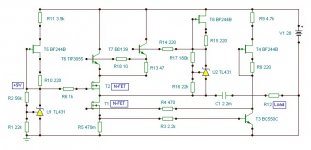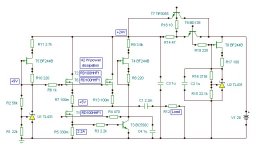MiiB,
every part modulates the signal and causes distortion. It is the designer`s job to decide whether the advantages are greater than the disadvantages.
Can you elaborate on what you mean?
every part modulates the signal and causes distortion. It is the designer`s job to decide whether the advantages are greater than the disadvantages.
Can you elaborate on what you mean?
Last edited:
you put in a cascode that modulates with your output.. but in the same token limits the possible swing....
I merely ask your purpose of doing this....??
I merely ask your purpose of doing this....??
Vladimir
How does Allen Bradley Do you any good...They are in other applications dull and matte in the sound and the carbon is noisy, that is compared to types like caddok....
michael
I proceeded from the reports of "tube" people, who compared good carbon resistors with tantalum foil Vishay, and finally they have choosen carbons. The carbons need some burning-in perid, I shall report about possible sound changes.
As for noise arguments, I do not think they important for the follower.
In any amplifier regardless topology, the audio signal passes through all parts, thus the power supply components, it would be weird if not.
You insist in refusing quite an obvious fact, that appropriate topology design DOES allow the audio signal to pass only part of the whole schematics, in particular by using shunt power supply.
Good morning Vladimir,
the audio signal only sees an impedance...
Yes, in case of a shunt power supply, schematics is separated from PS electrolytics by a current source, which has an impedance for alternating current close to infinity. In this understanding, an alternating current of output signal does not pass through PS behind this CS, and output signal is produced by dynamically sharing some fixed current with active regulating device of shunt PS.
Vladimir
Do you have at sense off weather the quality of this amplifier is due to to the fact that it is single ended or its the shunt nature that contributes most to its qualities...??
After thinking a little I'am reluctant to think that it is the latter....the shunts....and isolation from the PSU
I'll try to finalize the double shunt concept and also put some gain into a pre-stage so it can be driven from normal line level......I'll also design it with more normal and not so expensive mosfets....I hope there then could be some builders....
Do you have at sense off weather the quality of this amplifier is due to to the fact that it is single ended or its the shunt nature that contributes most to its qualities...??
After thinking a little I'am reluctant to think that it is the latter....the shunts....and isolation from the PSU
I'll try to finalize the double shunt concept and also put some gain into a pre-stage so it can be driven from normal line level......I'll also design it with more normal and not so expensive mosfets....I hope there then could be some builders....
MiiB,
the cascoding compound has nearly same the location as VT5, but the base is referred to the output. I mentioned one reason, otherwise, there´s much to say about cascodes.
the cascoding compound has nearly same the location as VT5, but the base is referred to the output. I mentioned one reason, otherwise, there´s much to say about cascodes.
Vladimir
Do you have at sense off weather the quality of this amplifier is due to to the fact that it is single ended or its the shunt nature that contributes most to its qualities...??
After thinking a little I'am reluctant to think that it is the latter....the shunts....and isolation from the PSU
I'll try to finalize the double shunt concept and also put some gain into a pre-stage so it can be driven from normal line level......I'll also design it with more normal and not so expensive mosfets....I hope there then could be some builders....
I am absolutely sure, the shunt topology contibutes much to sound perfection.
I see no problem to add an amplification stage to the follower, just common source stage based on J74, loaded on drain resistor or another J74 in a current source mode. The only doubt, such additional stage also needs shunt PS.
I use similar amplification stage as a separate preamp with shunt PS.
I was thinking on putting the pre-amplification stage on the same rails...and making it as a folded casode with two-shunt followers as the second stage... differentially driving the loudspeaker without the need for output caps...
class A in its least effective state.....🙂
class A in its least effective state.....🙂
WuYit
Why is the shunt concept a bluff and who are you to judge that.....??
you just give statements that are non backed....not very constructive...
M
Why is the shunt concept a bluff and who are you to judge that.....??
you just give statements that are non backed....not very constructive...
M
MiiB,
I have opinions like anybody else.
What I mean is that, disregarding the improper bias arrangement, the amplifier of this thread is an ordinary source follower, behaving as such, not more, not less. I can't see any particular shunt concept.
I have opinions like anybody else.
What I mean is that, disregarding the improper bias arrangement, the amplifier of this thread is an ordinary source follower, behaving as such, not more, not less. I can't see any particular shunt concept.
Single-ended sound plus electrolytic capacitor is to be preferred over push-pull sound with no capacitor. Please note, we are in the subjective domain. (The expression "single ended amplifiers working push pull" makes me crazy).I did not claim it to be an improvement...I just let the question hang in the air....because what is the lesser evil...the output capacitor or two single ended amplifiers working push pull..??
Right, single-ended amplifiers provide unbalanced output signal. Quasi complimentary push-pull stages require balanced input signal, some kind of phase splitter. I would not use a transformer. (The term "single ended push pull" makes me crazy).It is push pull driven by single ended amplifiers...thus single ended push pull...and it is a lot different than complimentary or quasi complimentary push pull....but off course they are all push pull in the broadest off terms.. (don't want to argue...)
and the question on how to make the balanced drive....via a transformer or floating or..??? so while the amplifier seems quite simple then the balanced drive could pose a problem....
... I can't see any particular shunt concept.It is really pitty that after 10 pages of this thread you still do not see shunt concept. But we must not be crying about this. One small IMHO, if you have an interest to sound differences from various topologies, just try and make own conclusions.
Thinking about audio equipment market, I see mainly two its parts - 1)those who care about sound, and 2) those who care about technical specs
These two parts are well separated, and the part 2) is much much bigger. Correspondingly, most designers work for part 2), and in this domain nothing more than sims, IMD, THD is needed, the way is straightforward.
Customers and disigners for part 1) live in subjective domain, since our hearing is still much more perfect "instrument" that spectrum analysers.
Please, understand this and do not use too much arms again the part 1), commercially it does not make any danger for part 2).
Vladimir,
you have misunderstood me, but it´s not entirely your fault. I don`t care about measured distortion and have already made my conclusions on topologies taking a firm stand for the single-ended amplifier. Just pointed at some misconceptions that led to design flaws.
Another variant, Vds still held pretty stable:
you have misunderstood me, but it´s not entirely your fault. I don`t care about measured distortion and have already made my conclusions on topologies taking a firm stand for the single-ended amplifier. Just pointed at some misconceptions that led to design flaws.
Another variant, Vds still held pretty stable:
Attachments
in an active system bellow 1KHz i would use push-pull design, from 1KHz-4KHz single ended, above 4Khz also single ended. In this moment i have an 2-way active system, cut-off frequency 3900Hz, for mid-bass region -push-pull, above 3900Hz SE design. Previous setup was passive speakers with one SE amp for full spectar.
Active system have better bass but the sound is not so natural, maybe because of active crossover (my opinion). I cant decide what sounds better. Both setup have good and bad sides. If i have to choose ill go for an SE design and passive speakers.
About circuit of Vladimir i would use a tube for gain stage
Active system have better bass but the sound is not so natural, maybe because of active crossover (my opinion). I cant decide what sounds better. Both setup have good and bad sides. If i have to choose ill go for an SE design and passive speakers.
About circuit of Vladimir i would use a tube for gain stage
Active system have better bass but the sound is not so natural, maybe because of active crossover (my opinion). I cant decide what sounds better. Both setup have good and bad sides. If i have to choose ill go for an SE design and passive speakers.
I guess, if built correctly, an active crossover should sound better than passive. This is based on the fact that one single woofer "sounds" better with active crossover. But when more than one drivers have to work together, the quality will of course be affected by the correctness of the crossover design.
It seems that, sound-wise, building a correct active crossover is not as easy as building a correct passive crossover. Many EE here may argue, but if you belief on golden ears existence, you have to know that active crossovers do sound different, in a bad way.
If more people have golden ears, the active crossover will not be so popular. But guess what, even if we don't have golden ears, the truth is still the truth, we just cannot hear it straight away. Sooner or later we will "perceive" the same thing.
About circuit of Vladimir i would use a tube for gain stage
Goran, The Aikido was not available when I built my PF99s. I have tried to modify my BOZ using more than 100V rail but couldn't solve the problem. I don't know why a tube should be better here. Is it because of the voltage gain?? I will try again using Vladimir's preamp (or Aikido) and use small mosfets for the modified PF99 (IRF630 or IRL510 or IRG4BC20UD-IGBT or laterals if the amp deserves it).
I know that they are considered too "small" by others but why not? I can add fans... and lower power of course.
Last edited:
- Status
- Not open for further replies.
- Home
- Amplifiers
- Solid State
- Modified Follower-99 With HF Transistors

